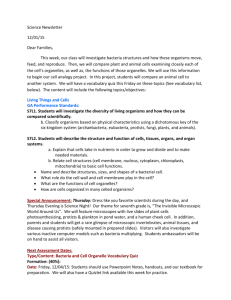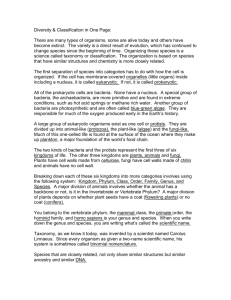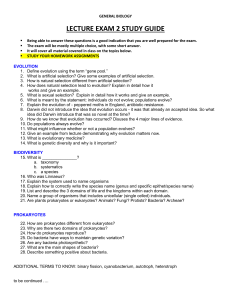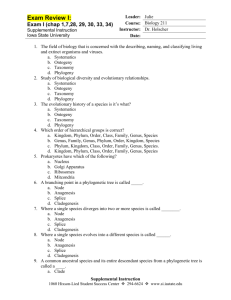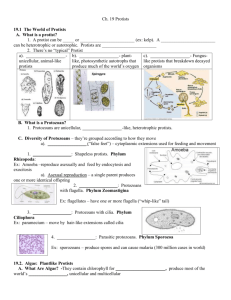Eukaryotic Cells
advertisement
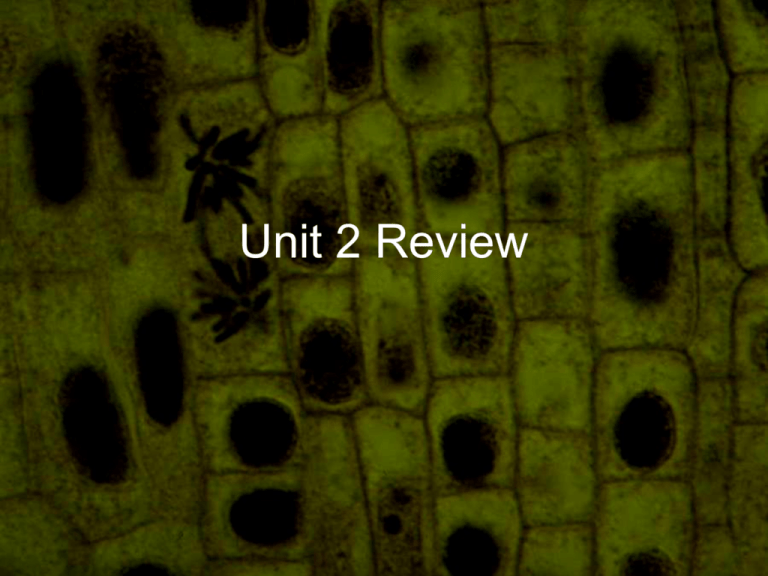
Unit 2 Review Cell Theory (Pg. 78) • All organisms are made up of one or more cells. • All cells carry on life activities • New cells arise only from other living cells by the process of cell division. Introduction There are two basic cell types: Prokaryotic Cells: Eukaryotic Cells: •Lack membrane bound organelles. • Present in all living things. • Internal membrane bound structures •Include bacteria Similarities between plant cells and animal cells Both have a cell membrane surrounding the cytoplasm. Both have a nucleus. Both contain mitochondria, golgi bodies, E.R. , ribosomes and microtubules. Know the basic functions of the organelles of the cell Differences between plant cells and animal cells Animal cells Plant cells Relatively smaller in size Relatively larger in size Irregular shape Regular shape No cell wall Cell wall present Differences between plant cells and animal cells Animal cells Plant cells Vacuole small or absent Large central vacuole No Chloroplasts Chloroplasts Present Nucleus at the centre Nucleus near cell wall Classification & Taxonomy • Know the classification systems developed by Aristotle and Theophrastus, John Ray, & Carolus Linnaeus. • What are the current 6 kingdoms of living things?? Naming Organisms • A system for naming things is called nomenclature. • Linnaeus named each species with a genus name followed by a species name. • This 2 word system of identifying each organism is called binomial nomenclature. • Most organisms also have a common name as well, but this is not always the best way to describe organisms. WHY USE SCIENTIFIC NAMES? • PEOPLE IN ALL PARTS OF THE WORLD USE THE SAME NAME FOR AN ORGANISM • RELATIONSHIPS AMONG ORGANISMS ARE EVIDENT IN THEIR NAMES • DIFFERENCES BETWEEN ORGANISMS ARE OBVIOUS FROM THEIR NAMES Kingdoms Archaebacteria and Eubacteria • • • • The kingdom formerly known as Monera Most abundant/diverse kingdom Prokaryotic organisms ONLY KINGDOM lacking an organized nucleus or membrane-bound organelles Nostoc (cyanobacterium) Structure Cell Wall Chromosomes Cilia or Flagella Prokaryotic Cell Eukaryotic Cell Yes Yes, Plants Only One long DNA strand Yes, Simple Many Yes, Complex Lysosomes No Common Mitochondria Nucleus No Yes No Yes Plasma Membrane Yes Yes Bacterial Shapes Metabolic Needs • All prokaryotes require an energy source and a food source. • Most are aerobic (Require oxygen) • Bacteria that cannot live without oxygen are called obligate aerobes. • Some bacteria, called faculative anaerobes, can live in the absence or presence of oxygen. • Some bacteria cannot live in the presence of oxygen. These are called obligate anaerobes. Reproduction Bacteria reproduce by binary fission which is an asexual process Bacteria usually follow a typical growth curve. Fig.30-4 The Gram Test • This is a universal method of classifying bacteria called Gram Staining. • This is a staining method developed by a Danish physicist named Hans Christian Gram. • It classifies bacteria by how they react to the stain. • Bacteria are divided into 2 categories: – Gram positive bacteria (Purple) – Gram negative bacteria (Pink) Pasteur and Germ Theory • Pasteur’s work set the ground work for what we now know about pathogens. 1. Bacteria become so numerous that they interfere with the functioning of normal cells. 2. They can destroy body cells and tissues. 3. They can produce poisons, or toxins, that kill cells or interfere with their functioning. This is usually the cause of harm. Koch’s Postulates 1. The suspected disease-causing organism should always be found in animals with the disease. 2. The organism must be isolated from the diseased animal and grown in a pure culture. 3. When organisms taken from the pure culture are injected into a healthy animal, they must cause disease. 4. The organism must be isolated from the experimentally infected animal and grown in pure culture again, and it should be identified as the same organism isolated in step 2. Vaccines • Jenner’s work (smallpox) led to many other scientist developing vaccines to prevent disease. Viruses are further classified based on three structural considerations: 1) The type and size of their nucleic acid 2) The size and shape of the capsid. 3) Whether they have a lipid envelope surrounding the capsid. Parts of a Virus 1. Capsid - The capsid is the protein shell that encloses the nucleic acid. • The capsid has three functions: 1. it protects the nucleic acid from digestion by enzymes, 2. Contains special sites on its surface that allow the virus to attach to a host cell. 3. Provides proteins that enable the virus to penetrate the host cell membrane and, in some cases, to inject the infectious nucleic acid into the cell's cytoplasm. Parts of a Virus 2. Envelope - Some viruses may have an additional covering on the outside called an envelope. • The envelope is actually a lipid bilayer (membrane) with proteins embedded within the membrane. 3. Nucleic Acid - Just as in cells, the nucleic acid of each virus encodes the genetic information for the synthesis of all proteins. • The nucleic acids in a virus can be RNA or DNA. The Lytic Cycle • The lytic cycle is one of the two cycles of viral reproduction, the other being the lysogenic cycle. • These cycles should not be seen as separate, but rather as somewhat interchangeable. • The lytic cycle is typically considered the main method of viral replication, since it results in the destruction of the infected cell. • The lytic cycle does not involve genetic material of the virus being integrated into the host’s DNA. Epidemic vs. Pandemic • An epidemic is a disease affecting or tending to affect an atypically large number of individuals within a population, community, or region at the same time • A pandemic is a disease prevalent throughout an entire country, continent, or the whole world; epidemic over a large area. Protists are divided into 3 main groups 1. Animal-like protists (Protozoa) 2. Plant-like protists (Algae) 3. Fungus-like protists Animal-like Protists • All protozoa are heterotrophic • Some absorb nutrients through their cell membrane, whereas others “engulf” larger food particles. • Most protozoa are motile and are divided into phyla based on their means of locomotion. Animal-like Protists • Classified based on ____________? • Phylum Sarcodina (amoebas) • Phylum Ciliophora (Paramecium) • Phylum Zoomastigina (zooflagellates – African Sleeping Sickness) • Phylum Sporozoa – Plasmodium (Malaria) CONJUGATION Plant-like Protists • Also known as Algae. • Algae are eukaryotes • Algae are photosynthetic, like plants: – Have 4 kinds of photosynthetic pigments – Many accessory pigments – blue, red, brown, gold • Require moist environments because they lack a waxy cuticle. A cuticle prevents water loss in terrestrial plants. Three Body Plans 1. Single Celled: Eg. Euglena (p. 646), Chlamydomonas (p.649), Diatoms (p. 648) 2. Colonial: group of unspecialized cells. Eg. Volvox (p. 99), Spirogyra (p. 426). 3. Multicellular: specialized division of labour. Eg. Kelp Classification of Algae • 1. 2. 3. 4. 5. 6. Classification of Algae is based on: Color of major pigments Method of storing food (starch, oil, sugars). Cell structures: Cell wall, pellicle. Body plan Flagella Reproduction Plantlike Protist Phyla • • • • • • Phylum Euglenophyta (Euglena) Phylum Chrystophyta (Diatoms) Phylum Dinoflagellata Phylum Rhodophyta (red algae) Phylum Phaeophyta (Kelps & Brown algae) Phylum Chlorophyta (Green algae) • 1. 2. 3. • 1. 2. a) Reproduction Asexual: Fission Fragmentation Asexual spores (resistance to drought) Sexual: Conjugation – Spirogyra (p. 426) Sex Cells Isogamy – union of gametes of same size and shape; different DNA b) Heterogamy – union of unlike sex cells in size and shape. Specialized large ♀ egg cell and small motile ♂ sperm. Reproduction • Algae have an alternation of generations: – Gametophyte Generation – Largest most obvious part of the life cycle (n). – Sporophyte Generation – Short lived less conspicuous part of the life cycle (2n). Fungi-like Protists • These protists are similar to the fungi in some ways. These protists have some stages in their life cycle that are similar to those of protozoa. • All fungus like protists are heterotrophic, most are decomposers and a few are parasites. Three major phyla of fungus like protists 1. Myxomycota (acellular slime molds) (feeding stage called a plasmodium) 2. Acrasiomycota (cellular slime molds) 3. Oomycota (water molds and downy mildews) Fungal Characteristics • Eukaryotic • Multicellular (with one exception) • Heterotrophic • Absorb nutrients - may be saprobes (absorb from dead material), parasites, or mutualistic symbionts (with algae make lichen). The Body Plan of Fungi • Vegetative body consists of mycelia made up of networks of hyphae • Hyphae - Long threads of cells designed to maximize surface area and also transport nutrients Fungal Phyla • • • • Zygomycota – Conjugation Fungi – Bread Mold Ascomycota – Sac fungi – Truffles & yeast Basidiomycota – Club Fungus – mushrooms Deuteromycota – Imperfect Fungus – Athlete’s foot, pennicillium • Named for their sexual spore producing structures: Zygomycota – Zygospores; Ascomycota – Ascospores; Basidiomycota – Basidiospores; Deuteromycota – sexual reproduction unknown.
